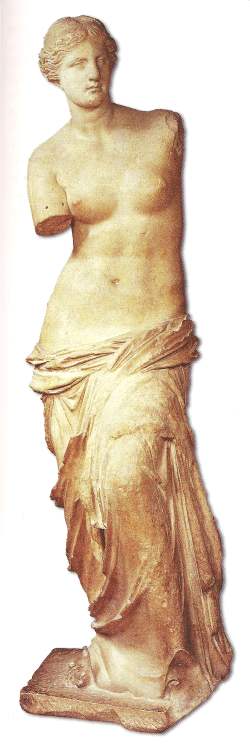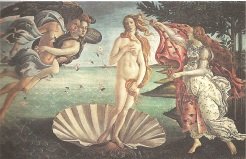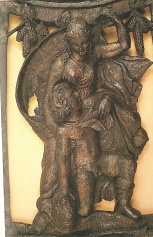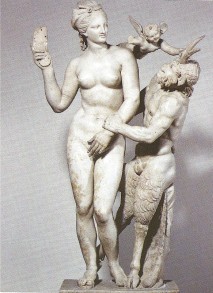|
Aphrodite, the goddess who emerged from the sea foam

Aphrodite was the Olympian goddess who represented beauty and love. According to Homer, "she inspired love and lust among the gods and mortals. And all the creatures that live on land or in the sea" (Homer, Hymn to Aphrodite).
Although Homer describes her as the daughter of Zeus and the Titan or the oceanid Dione, it is certain that the cult of the goddess of love arrived in Greece from the east, via Phoenicia, Cyprus and Cythera.
Click on the following links to go directly to the relevant chapter:
The goddess’s birth
Liaisons with Olympian gods
Liaisons with mortals
Goddess’s involvement in other love schemes
Goddess’s Cult and Symbols
The birth of Aphrodite, as depicted in a Renaissance painting
 |
In ancient greek literature, there are quite diverse versions of how the goddess of love was born. According to the creation myth narrated by Hesiod in Theogony, the goddess arose from the foam that formed in the sea around Uranus’s severed manhood, after being tossed to the sea by his son Cronus. She is thus known as Aphrodite Urania, or Aphrogeneia (born of the foam).
According to a different version, the goddess emerged from a sea shell in which she was taken to Cythera.
[top]
Being the goddess of love, Aphrodite naturally associated herself with a wide range of myths, which either describe her immediate involvement in amorous adventures with both gods and mortals, or describe her role in instilling love or lust to people whom she wanted either to punish for whatever reason, or assist them in fulfilling their sexual desires they had towards others.
Even the supreme god Zeus could not help falling victim to Aphrodite’s charms and beauty. However, he was cautious enough, so that whenever the goddess of love lured him into some erotic adventure, he took care to conceal it from his legal bride Hera.
As far as her legal relationships are concerned, Aphrodite is sometimes described as being married to the lame fire god Hephaestus and sometimes to the war god Ares, with whom she had Eros, Harmonia, Deimus (Fear) and Phobus (Panic). According to Homer, Aphrodite was legally married to Hephaestus, but was unfaithful to him with Ares.
It is interesting to note the symbolism behind the birth of Harmonia, daughter of Aphrodite and Ares: Their union symbolizes the idea that harmony is a blend of harsh and tender, or wild and tame characteristics. In other words, it represents the concept that love and hate, as well as as disaster and creation are the necessary elements of life, which coexist.
[top]
Aphrodite and Adonis
 |
As mentioned above, Aphrodite did not limit her lustful desires only for gods, but for mortals as well. As a matter of fact, Zeus instilled in her the lust for mortals, as punishment for her acts of making gods fall in love with mortals themselves.
The most notable myths describing the goddess’s amorous adventures with humans are two: The first one describing her infatuation with handsome Anchises and the other one, which is the most well known, is the myth with young Adonis.
- Anchises was tending his herds on Mount Ida in Crete, when the goddess caught a glimpse of him and fell in love. When she rushed to meet him, she falsely pretended to be a mortal herself, assuming the identity of the daughter of the Phrygian king Otreus, who had come to marry young Achises, on the order of god Hermes.
After he succumbed to her lustful desires, Anchises realized to his horror that indeed he lay with a goddess, rather than a mortal. Aphrodite assured him that no harm would happen to him and revealed to him that she would bear him a son, by the name of Aeneas who would be raised by the nymphs who lived in the mountain.
However, she implored the young mortal never to reveal the true identity of his son, because if he did, he would enrage Zeus who would strike him (his son) with a thunderbolt, in retaliation.
- According to ancient greek myths, Adonis was born out of a quarrel that the goddess of love had with Myrrha or Smyrna, who was the daughter of the Assyrian king Theias.
As the myth goes, the animosity between the two females, that is between Aphrodite and the mortal princess, began when the latter refused to worship the former. In retaliation to the girl’s lack of respect towards her, the goddess inspired in her (the princess Smyrna), an insatiable lust for her father. When he was finally tricked into consuming their relationship, king Theias became so enraged at his daughter, that she begged the gods to save her.
Her prayers were heard and she was turned into a myrrh tree. Then months later, the trunk of the tree was split halfway and a handsome young man, Adonis, emerged.
Aphrodite became quickly infatuated with the young man and shut him in a trunk that she entrusted to Persephone, asking her to hide him from gods and mortals.
But Persephone fell in love with the handsome youth herself, refusing to return him to the goddess. Unable to reach an agreement, the two women sought Zeus’s advice to resolve their dispute. As a solution, the mighty ruler of Olympus divided the year into three periods: In the first period, Adonis would spend his time as he pleased, the second period he would devote his time to Persephone and the third period he would stay with Aphrodite. Finally, Adonis chose to spend his free time (the first period of the year) with the goddess of love.
Unfortunately, Adonis had a tragic end: During one of his hunting trips in the forest, he came face to face with an enormous wild boar. As a result, he was fatally injured. Watching the scene from afar, Aphrodite rushed to his aide.
As the myth goes, in her haste she forgot to put on her sandals and a rose thorn pricked her foot. The blood from the wound trickled on some white roses, turning them into bright red.
Devastated by her lover’s tragic faith, the goddess laid him on a bed of lettuce plants, which, according to ancient Greeks, took on aphrodisiac qualities, because of this act. The flower wild anemone, is also said to have grown from the tears that the goddess shed for her lost lover.
There are two versions, related to the true identity of the wild beast who killed Adonis: It was either the god of war Ares who was envious at the goddess’s affection towards the young man, or god Apollo, who sought to avenge the son of Erymanthous, whom Aprhodite blinded because he saw her bathing after her erotic encounter with Adonis.
It is noteworthy to say that, in ancient Greece, Adonis was the object of true worship. The focus of his cult was the mysteries known as Adoneia in which mostly women took part. According to ancient sources, similar practices were carried out in Syria and Egypt.
[top]
Aphrodite and Pan
 |
Apart from her own amorous adventures with gods and mortals, Aphrodite, being true to her capacity as the goddess of love, had active involvement in other love affairs, which had astounding side effects: They either led to outbreak of wars, made daughters and wives turn against their fathers, their husbands and their country, or led to numerous other events with tragic outcomes.
Some of these heart-touching myths are listed below:
- Helen of Troy: One of the most famous victims of Aphrodite is Helen, the beauty over whom the Trojan War was fought. The goddess’s victory in the famous beauty contest where the Trojan prince Paris was the judge, led to the abduction of Helen, wife of king Menelaus of Sparta. This act triggered a chain of events which ultimately led to the outbreak of the most famous war in Greek Mythology, namely the Trojan War.
Click here to read all about the exciting adventures of the Trojan War.
- Medea: The goddess of beauty played an especially important role in the expedition of the Argonauts, as Jason took advantage of the passion that the goddess inflamed in Medea’s heart to steal the golden fleece and escape from Colchis.
Click here to learn morel about Jason and the Argonauts.
- Pasiphae-Ariadne-Phaedra: The wife (Pasiphae), as well as the two daughters (Ariadne and Phaedra) of the Cretan king Minos, all became tragically entagled in a web of love and lust, genuinely set up by the scheme-lover goddess of beauty.
Initially, the goddess turned against Pasiphae, daughter of Helius, when her father tipped off Hephaestus to Aphrodite’s extramarital affair with Ares. Unable to punish Helius for his misdemeanor, the goddess turned against his daughter Pasiphae instead, by instilling in her an insatiable lust for a bull that god Poseidon had given to her husband Minos, as a gift. From the queen’s union with the beast, the monster Minotaur was born, who was later killed by Theseus, during his expedition to Crete.
Made by Aphrodite to fall in love with the hero, Ariadne was Theseus’s aide in finding his way in the labyrihth and finally kill Minotaur.
Click here to learn in detail the story of Theseus, Pasiphae and Ariadne.
The most tragic story is linked with Phaedra, the other daughter of Minos, who became the second wife of Theseus. Aphrodite, angered by the fact that Hippolytus, son of Theseus and the amazon Hippolyte, was ignoring her amorous advances, she ignited in Phaedra an illicit lust for her stepson.
Click here to find more about the bitter end of the tragic story of Theseus’s wife and his son.
- Atalante: A story of love with a happy ending, is also associated with the goddess of love and beauty. This is the myth of Atalante, a young virgin who, abhorred by the idea of getting married, submitted all those who sought her hand into a test. The test was a foot race. The virgin would have her young suitors set out first;she would then race behind them, overtake them and kill them.
The young virgin was finally outwitted by young Melanippus (or Melanion), who was assisted by Aphrodite. What the goddess did was to give Melanippus, before the race, several of the apples of Hesperides. During the race, the young man would drop one of the apples, whenever Atalante was drawing nearer to him. The young girl would stop to pick the apple, thus letting her opponent to gain ground. After employing his trick several times, Melanippus finally managed to win the race and, at the same time, the heart of Atalante. This happy turn of events finally led to the marriage of the two youths.
- Selemnus: One example of Aphrodite helping mortals to overcome their grief over an unsuccessful relationship, is manifested in the story of Selemnus, a young shepherd who fell in love with the nymph Argyra.
When the man lost his looks because of ageing, his object of affection deserted him. As a result, the poor man died of his grief. The goddess of love, deeply moved from his love, turned the man into a river.
Yet, even after his transformation, Selemnus remained grief stricken. So, the goddess came to his aid a second time and gave him the ability to erase from his memory the pain over his lost love.
Based on this myth, ancient Greeks worshipped the river Selemnus and turned to him, whenever they wanted assistance to overcome their own grief about a love gone bad.
[top]
Statue of Aphrodite found in Cyprus
 |
Several ancient sources confirm the eastern origin of Aphrodite’s worship. Pausanias writes that the Assyrians were the first to worship Ourania. Her cult was later spread to Paphos in Cyprus and then to Cythera. There is evidence that the goddess was known by many epithets: The Assyrians called her Mylitta, the Arabs called her Alitat, the Scythians Argimpasa and the Persians called her Mitra.
According to Cypriot tradition, the followers of the goddess would prove their devotion by laying with strangers; a fact attested by the historian Strabo, who records the existence of over a thousand hetaire, or courtesans, at her sanctuary at Acrocorinth.
Aphrodite’s links to Cyprus and Cythera are clearly evidenced by additional epithets she had like Cypris, Cythereia and Papheia. In addition, her most important sanctuaries have been found in Paphos, Idalios and Amathounta (all ancient cities of Cyprus).
In the Mediterranean, important sanctuaries dedicated to the goddess have been found in Cnidus, Halicarnassus, Ephesus and Abidus.
The cult of Aphrodite was especially widespread on the islands of Cos and Rhodes, while on Delos it was believed that a xoano, or wooden idol, of the goddess had been brought to the island by the hero Theseus.
Her myth of being born from the sea foam, naturally associated the goddess with the sea. Thus, a lot of temples dedicated to her, are located either along the coasts, or in harbors or capes. Examples are the temples at Aegeio, Patra, Cnidos, Attica etc.
The goddess’s most important symbol is the breastplate and belt. According to Homer, Aphrodite gave this belt to Hera, so that she could charm Zeus. In ancient depictions, she is also shown to be wearing a wreath, which is also considered to be one of her symbols.
Objects of beauty such as the perfumed clothing she was wearing when she stood before Paris in the famous beauty contest, as well as her sparkling jewellery, are typical accessories of the magnificent goddess as well.
Plants sacred to the goddess are the rose, myrtle, anemone, pomegranate, polly and apple. The dove, swan, goose, the tortoise and the rabbit were some of the representatives from the animal kingdom, who were considered to be sacred to the goddess. Also, the dolphin symbolized her origin from the sea.
Return from Aphrodite to Greek Pantheon
Return from Aphrodite to igreekmythology.com home
|
|











